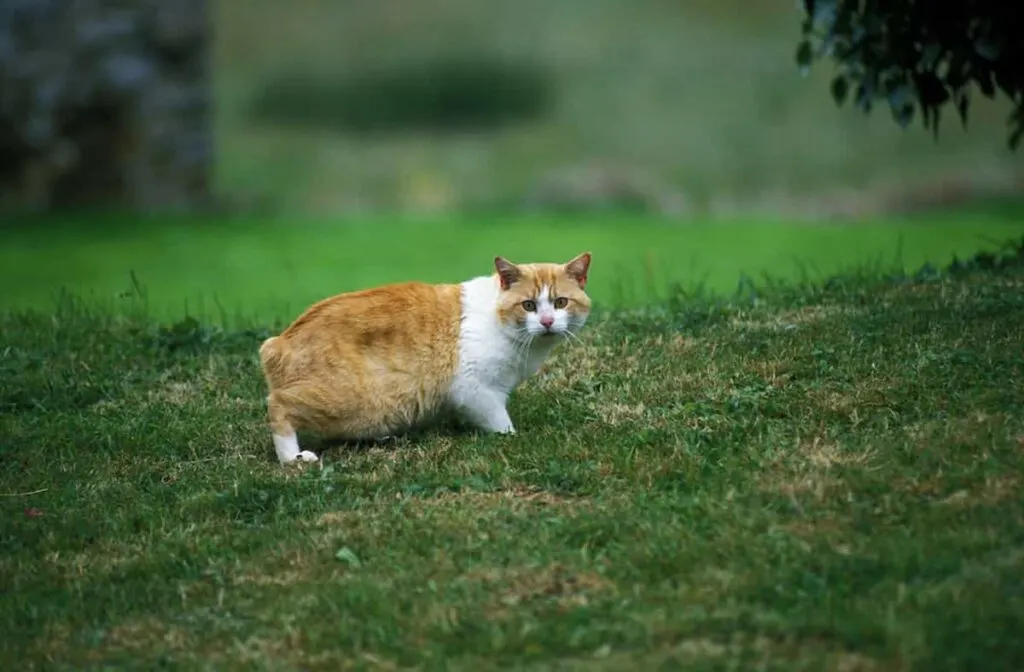Cats are known for their incredible balance and agility, often attributed to their long, flexible tails. However, not all cats have tails, yet they still manage to easily maintain their balance. This raises the question of how cats without tails can balance themselves.
While a cat’s tail seems crucial for balance, this is not entirely true.
So, how do cats without tails balance themselves without this important appendage? It turns out that cats are incredibly adaptable creatures, and they are able to compensate for the lack of a tail by using other parts of their body to adjust their balance. This includes their powerful hind legs and claws, which they use to grip surfaces and stabilize themselves as they move.

Anatomy of Cats Without Tails
Understanding a cats body structure is key in seeing how not having a tail isn’t the most important factor in their balance.
Muscles and Bones
Like the Manx breed, cats without tails have a unique anatomy that allows them to balance without relying on their tails. Their spines are shorter than those of other cats, and their back legs are longer, which gives them a unique gait and center of gravity. Their hips and hind legs are also more muscular to compensate for the lack of a tail.
The muscles in a cat’s tail control its movement and balance. Cats without a tail rely on other muscles to maintain their balance, particularly those in the hind legs and core. These muscles work together to help the cat adjust its center of gravity and maintain stability while walking, running, or jumping.
Additionally, cats without tails have a unique bone structure that helps them balance. Their pelvis is wider than other cats, providing a more stable base for their hind legs. Their spine is also more flexible, which helps them adjust their body position and maintain balance.
Tailless Breeds
There are several breeds of naturally tailless cats, including the Manx, Cymric, and Japanese Bobtail. These breeds have a genetic mutation that causes them to be born without a tail or with a very short tail.
The Manx breed is the most well-known of the tailless cats. They originated on the Isle of Man, where they were prized for their hunting skills. The mutation that causes their taillessness is believed to have occurred naturally on the island, and the breed was selectively bred for its unique appearance.
The Cymric breed is a long-haired version of the Manx and also lacks a tail. On the other hand, the Japanese Bobtail has a short, pom-pom-like tail resulting from a different genetic mutation.
Despite their lack of tails, these breeds can still balance and move with agility. Their unique anatomy and muscular structure allow them to compensate for the missing appendage and maintain their balance.

Balancing Techniques
Without a tail, cats can use other techniques to balance. Here are a few to consider.
Lowering Center of Gravity
Cats without tails have to rely on their body movements to balance themselves. One of the techniques they use is lowering their center of gravity. This means they crouch down and spread their legs apart to create a wider base. Doing this makes them more stable, and they can maintain their balance even without a tail.
Using Paws and Claws
Cats also use their paws and claws to help them balance. They grip surfaces tightly with their claws to prevent slipping or falling. They also use their paws to adjust their body position and shift their weight. This allows them to make quick and precise movements to maintain their balance.
Compensating with Body Movements
Finally, cats without tails compensate for their lack of balance by using their body movements. They twist and turn their bodies to shift their weight and adjust their center of gravity. They also use their head and neck movements to help them maintain their balance. For example, when a cat jumps, it will tilt its head and neck upwards to help it land on its feet.

Adaptations for Tailless Cats
Other ways cats adapt without tails include more enhanced senses working together with their flexible bodies.
Enhanced Senses
Cats without tails have adapted to rely more heavily on their other senses to maintain balance. Their inner ear and vestibular system have become more sensitive, allowing them to detect even the slightest changes in their body position. This heightened sense of balance allows them to quickly adjust their movements to prevent falls or slips.
In addition, tailless cats have also developed enhanced vision. Their eyes work in tandem with their vestibular system to help them maintain balance. They can quickly adjust their gaze to focus on objects and changes in their environment, allowing them to react quickly and maintain their footing.
Flexible Spines
Cats without tails have also developed more flexible spines to compensate for the loss of their tail. Their spines can bend and twist more easily, allowing them to make quick and precise movements to maintain their balance. This flexibility also allows them to land safely when jumping or falling, preventing injury.
Another adaptation is the development of longer hind legs, which help to distribute their weight more evenly and provide additional stability when standing or walking. This allows them to maintain their balance even when performing complex movements or navigating challenging terrain.

My name is James, and welcome to FAQCats!
Along with our team of cat owners, expert pet enthusiasts, and pet professionals, we aim to write engaging helpful, engaging content about cats. At FAQCats we strive to provide content that’s accurate and fun to read. Our team writes about everything related to cats; even the most complex of topics. Through extensive research and caring for our own fur-pals, we’re able to provide something cat owners worldwide will love. Have a look around, and leave us feedback anytime!

